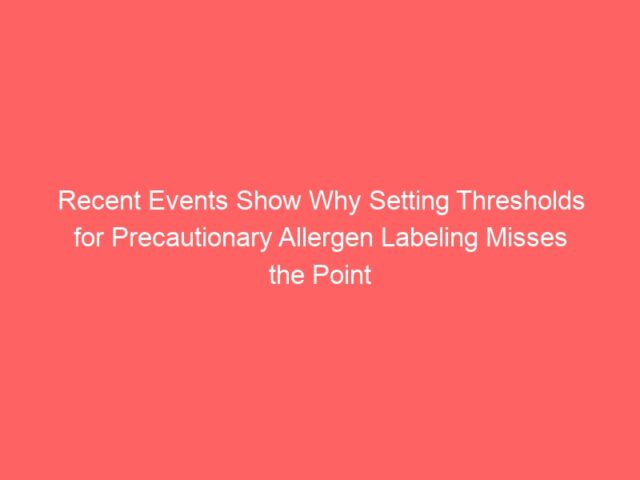The present state of Precautionary Allergen Labeling (PAL) on meals merchandise within the US is dangerously inconsistent. PAL statements—comparable to “Might comprise sesame” or “Made in a facility that additionally processes milk”—are totally voluntary. This ends in a complicated, unstandardized system the place some producers embrace such warnings, many giant ones don’t, and others selectively warn for some allergens however not others.
This lack of Meals and Drug Administration (FDA) regulation leaves the meals allergy neighborhood uncovered and reliant on the goodwill of producers. The absence of standardization extends not solely to whether or not a warning is current but additionally to the wording and placement of the assertion.
Why the Proposed Answer Falls Quick
The FDA is contemplating a regulatory method based mostly on setting allergen thresholds endorsed by the World Allergy Group. The present normal into account is ED05, which stands for the eliciting dose—the quantity of allergen which will set off a response—in 5% of the allergic neighborhood.
Sadly, this deal with a quantitative threshold misses a important level: it solely addresses the danger of unavoidable cross-contact throughout regular manufacturing. It doesn’t account for the danger of human error or a significant, unannounced change in a product’s method.
The Downside with Focusing Solely on Thresholds
Two real-world incidents illustrate why the allergic neighborhood wants full transparency about which allergens are processed in a facility, no matter threshold testing:
- Manufacturing Errors and Undeclared Allergens: Final week, a nationwide recall of Jody’s Inc. Cabot Creamery Sea Salt Caramel Cheddar Popcorn on account of undeclared peanuts highlights this danger. The recalled luggage mistakenly contained entire peanuts—not on account of hint cross-contact, however a transparent error on the manufacturing line. Whereas the packaging did carry a PAL assertion for peanuts, the important thing info for a person with a peanut allergy is realizing that peanuts are processed in that facility in any respect, which is probably not the case going ahead if this product falls beneath the proposed ED05 threshold. This information is important to protect towards labeling, packaging, and manufacturing errors that happen outdoors of regular protocol.
- Tragic Penalties of Unannounced Ingredient Adjustments: The tragic passing of 25-year-old dancer Órla Baxendale in 2024 demonstrates the hazard of ingredient modifications. Ms. Baxendale, a lady with a peanut allergy who was a vigilant label reader, consumed a cookie bought at a Stew Leonard’s that led to her dying by anaphylaxis. The label she learn didn’t mirror a latest, unannounced method change by the producer, Cookies United, which had begun including peanuts as an ingredient. Had a PAL warning been current stating that peanuts had been processed within the facility, it’s seemingly she would have averted the cookie that finally claimed her life.
The Answer
The answer isn’t advanced, however it requires a basic shift in regulatory precedence.
What is important is a single, obligatory blanket assertion for use every time a high allergen is processed in a facility, no matter ingredient thresholds or inner testing protocols, comparable to:
“Made in a facility that additionally processes [Allergen].”
This straightforward, required disclosure would offer the knowledge vital for an allergic shopper to evaluate their very own danger. If the FDA chooses to allow a secondary, supplemental assertion that the product meets the proposed ED05 threshold, it might accomplish that, to offer much more salient info. However at the start, customers should have full transparency about which allergens are current within the manufacturing atmosphere to guard towards all types of danger—each routine cross-contact and catastrophic human error.
SnackSafely has proposed 4 simple-to-implement modifications that the FDA ought to undertake to make allergen labeling considerably safer for the allergic neighborhood. Examine them and signal the petition urging the FDA to take motion.
What do you suppose? Please remark beneath to offer your perception.













